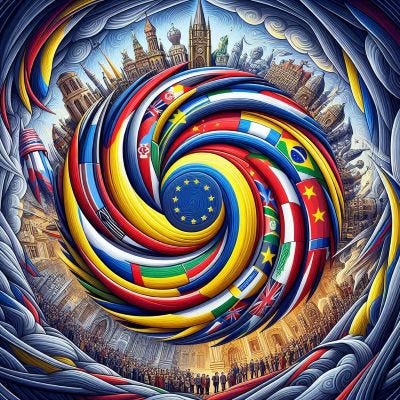After more than three years of war, the prospects of peace for Ukraine remain slim. There is no obvious, credible pathway even to a ceasefire, given Russia's refusal to extend a brief and shaky truce over Easter — despite the US, UK and Ukraine all signalling their support for this idea. And even if the considerable hurdles impeding a ceasefire deal could be overcome, a more fundamental problem would remain: none of the key players in the conflict appear to have a plan for an agreement that is likely to be acceptable to both Kyiv and Moscow.
Less than a year ago, there were at least seven different third-party peace proposals.
At one level this is surprising. Less than a year ago, there were at least seven different third-party peace proposals. Among them, China, Brazil, Indonesia, Saudi Arabia and the Vatican had their distinct visions for how to achieve peace. In addition, there was a multilateral proposal by a group of African states, led by South Africa, and a joint proposal by China and Brazil.
The best that could be said about these plans last autumn was that several of their sponsors had converged around the principles of the China-Brazil proposal by forming a Chinese-led "Friends of Peace" group in the margins of the UN General Assembly in September 2024. Remarkably — because it was in clear contravention of the western opposition to a ceasefire at the time — EU and NATO members Hungary and Slovakia also joined the group, alongside South Africa, Egypt, Indonesia, Türkiye, and other countries from the global south. By the end of 2024, this initiative, however, clearly had run its course and arrived at a dead end, as indicated in a short press release after the only other meeting the group held at the level of their countries' permanent representatives to the UN. A statement on what Beijing calls the Ukraine crisis by China's foreign minister, Wang Yi, on March 7, 2025, made no mention of the group. More importantly, that statement also seemed to indicate that China was no longer pursuing an active role in mediation, limiting its involvement to simply welcoming and supporting "all efforts for peace".
What these plans had in common was their primary focus on a ceasefire as a stepping stone to negotiations about an actual peace agreement. They were all light on detail of what a peace deal between Russia and Ukraine would entail but were nonetheless roundly rejected by Ukraine and its western allies as favouring Russia. Given that a ceasefire would simply freeze the front lines and very likely make them permanent with or without a subsequent peace agreement, this was not an unreasonable position.
Except that what Ukraine proposed instead — and what its western allies backed, at least rhetorically — was hardly more viable. Ukrainian President Volodymyr Zelensky's 2022 peace plan was already on life support at the time of the first "Summit on Peace in Ukraine” in Switzerland in June 2024. And when merely 84 of the 100 delegations attending the summit (out of 160 invited) supported a watered-down version of Zelensky's plan in their final communique without agreement on a follow-up meeting, Ukraine's peace plan was dead in the water. Its 'replacement' — Ukraine's internal resilience plan — with its focus on ensuring that the country can survive a long war of attrition with Russia is anything but a peace plan.
Among its European allies, the absence of a peace plan is similarly glaring, albeit for different reasons. Europe remains committed to supporting Kyiv, but the Russian war against Ukraine is only one — though clearly the most important — security priority for an emerging coalition of the willing among western backers of Ukraine. For them, it is important to keep Ukraine in the fight while they build up their own defences in a new international order in which the world might well be carved up into American, Russian and Chinese spheres of influence.
Such a carve-up is at the heart of efforts by US president Donald Trump who seeks to secure a ceasefire between Russia and Ukraine, as well as a deal that would give the US privileged access to Ukrainian resources, partly as a repayment for US support in the war to date. The latter appears to be relatively close to conclusion after it initially fell apart during an extraordinarily acrimonious press conference in the White House on February 28.
The ceasefire deal Trump appears to envisage would divide Ukraine itself into spheres of influence…
The ceasefire deal Trump appears to envisage would divide Ukraine itself into spheres of influence — as recently suggested by Trump's special envoy for Ukraine, retired general Keith Kellogg. Yet even such a pro-Moscow arrangement that would offer Putin control of 20% of Ukraine continues to elude negotiators, primarily because Russian president Vladimir Putin has few incentives to settle for less than Russia’s maximum demands and stop a war that he thinks he is still able to win on the battlefield, especially in light of Trump's unwillingness to exert any meaningful pressure on Russia.
At times, it now appears almost as likely that Trump will simply abandon his efforts to end the fighting in Ukraine. From a Russian perspective, this would be a preferable scenario compared to a ceasefire without the prospect of a favourable peace agreement reflecting Russian demands. The likely calculation in the Kremlin is that even when accepting that Trump’s monopoly of power may be undermined in mid-term elections at the end of 2026, Russia will have at least two more years to conquer yet more Ukrainian territory. Should Washington then make another push for a ceasefire, Moscow could claim its additional conquests as a price for Ukraine to pay for a settlement.
Even if Trump does not walk away from negotiations now, and even if his special envoy Steve Witkoff ultimately manages to cobble together a deal, this will still more likely look like a ceasefire than like a peace agreement.
The simple reason for this is that Russia's and Ukraine's positions on an acceptable outcome have not shifted. Putin remains committed to the full annexation of four Ukrainian regions (in addition to Crimea), while Zelensky has repeatedly ruled out territorial concessions and is broadly supported by Ukrainians in this stance.
On the western side, the reality that a peace agreement is close to impossible on terms satisfying all sides has become a self-fulfilling prophecy.
On the western side, the reality that a peace agreement is close to impossible on terms satisfying all sides has become a self-fulfilling prophecy. To the extent that there are any joint efforts by Ukraine, the US and the European coalition of the willing, they are completely centred on a workable ceasefire. At a meeting of foreign ministers and high-level officials in Paris on April 17, discussions were focused on making such a ceasefire sustainable. While details of how this can be achieved remain unclear, the fact that there now appears to be a more inclusive negotiations track signals progress, at least on the process of negotiations. Whether this will lead to an actual breakthrough towards a sustainable ceasefire, however, will depend on their substance and whether Ukraine and Russia can ultimately agree on terms about disengagement of forces, monitoring, and guarantees and enforcement mechanisms.
This is an already incredibly high bar, and the bar for a subsequent peace agreement is higher yet. In the current stage of Russia's war of aggression against Ukraine, a ceasefire is clearly a precondition for a peace agreement. But the sole focus on the former will not make the latter any more likely. What's more, given Russia's track record of reneging on the Minsk ceasefire agreements of September 2014 and February 2015, investing everything in a ceasefire deal might turn out not just a self-fulfilling, but a self-defeating prophecy for Ukraine and its supporters.
This is an updated and expanded version of an analysis published by The Conversation on April 22, 2025.
We hope you'll share Navigating the Vortex with anyone you think might find it of interest. Also, you can listen to our podcast editions via the website and on all major podcast platforms, including:












